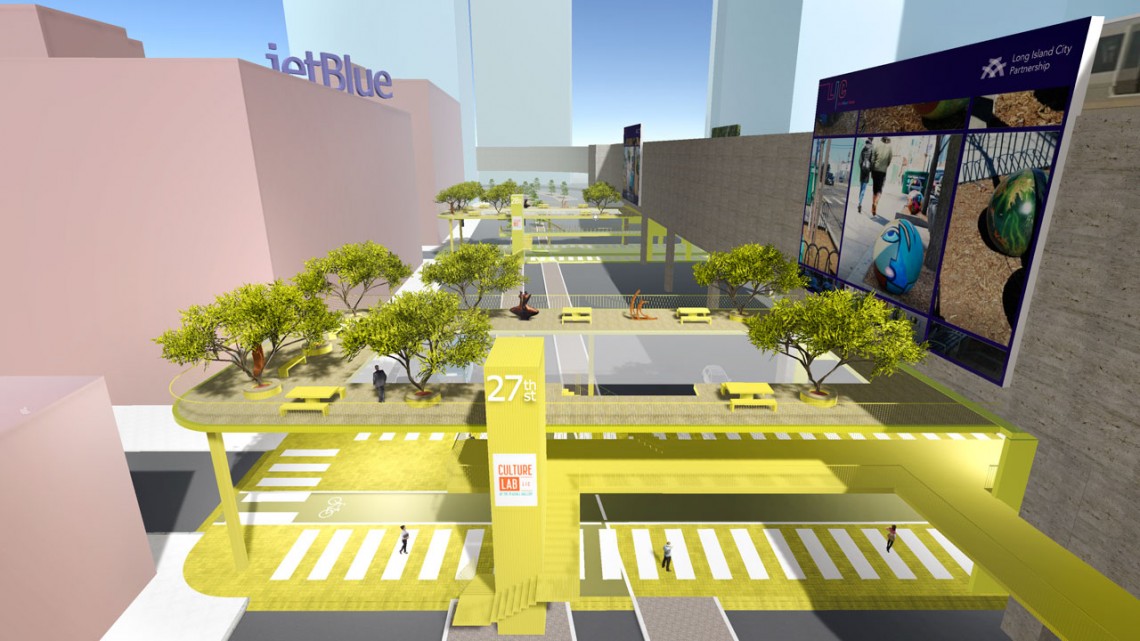
Urban Design Strategies students in New York City envision pedestrian-friendly walkways, improved lighting, safety – all with less noise – at Long Island City’s Queensboro Plaza subway stop.
NYC urban design course technology recaptures humanity
By Blaine Friedlander
At the heart of Long Island City – across the East River from midtown Manhattan – sits the Queensboro Plaza subway stop.
It’s a long, elevated platform featuring nothing but steel beams, rails and trains. Beneath the station, crossing the boulevard is not for the meek, as pedestrians hope to cross the fat streets in time to elude speeding cars and trucks. Above, the trains rumble and generate a ceaseless cacophony of high-decibel noise.
Through design, pedestrians may one day walk safely and the noise can be reduced.
In partnership with faculty from Cornell’s Department of City and Regional Planning, in the College of Architecture, Art and Planning (AAP), along with faculty and students from Cornell Tech, Jacobs Technion-Cornell Institute students have been taking a pilot Cornell course this semester – Urban Design Strategies and Case Studies. Using New York City as their laboratory, the students incorporate augmented-reality (AR) and virtual-reality (VR) into a technology driven tangible world.
The result: a return of humanity.
“With the Queensboro Plaza area, the students have researched how to make an inviting, safer place,” said Robert Balder ’89, executive director of the Gensler Family AAP NYC. Balder was the creator and faculty co-instructor for the course, which is part of the core-curriculum for the new Jacobs Urban Tech concentration. He co-taught the class with Sharon Yavo Ayalon, Technion B.Arch ’01, M.Sc ’10, Ph.D. ’19, postdoctoral associate at Cornell Tech. Ron Brachman, professor of computer science and the director of Jacobs Technion-Cornell Institute, worked with Balder and Ayalon to develop the course.
“From an urban design perspective,” Balder said, “this is an opportunity to improve the quality of life on the street and make it easier to navigate. The students are thinking about connections.”
Each of the course’s four student teams engaged with a New York City Business Improvement District, or a BID. In addition to the Long Island City partnership, the students focused on the Flatiron/23rd Street Partnership in Manhattan, where district boundaries are expanding; the Village Alliance, with a focus on University Place, a road connecting Union Square and Washington Square Park in Manhattan; and the Downtown Brooklyn Partnership. The students provided final presentations on May 20.
As for the Long Island City team, the group proposed pedestrian-friendly walkways with improved lighting and safety, more space for relaxation – during the lunch hour, for example – in elevated space featuring art, benches and a view.
Using an off-the-shelf Unity game engine – learned during the class – the team created a virtual reality demonstration to show the different phases of the possible project. Chris Morse, M. Arch ’16, visiting lecturer, led the Unity training throughout the semester.
“We created the VR demonstration to convey our idea in an immersive way to different stakeholders,” said student Matan Amihai, a Long Island City team member. “This helps them better understand how our intervention can create a better and necessary urban environment for pedestrians.”
In addition to Amihai, the other Long Island City team members are Jeremy Shaffer, Harrison Yu and Cheng Gong.
While the LED lights are bright on Broadway, the Flatiron/23rd Street Partnership aims to fuse technology and art to project animated lights on the historic buildings – using the buildings as canvas – along the Broadway corridor south of Times Square.
Their idea aims to showcase historic buildings and architecture, use AR on smartphones to increase the foot traffic at local eateries and shops, engage creative institutions, identify local neighborhood assets and promote pedestrian safety.
The “Animating the Broadway Corridor” student team members are Brandt Beckerman, Netania Kligerman, Rebecca Lassman and Isaiah Murray B.A ’20, B.S. ’20.
Sometimes, it takes a Village Alliance. This student team took a strategic approach to encourage engagement along the University Place corridor.
“Community engagement can sometimes be confusing,” said the Village Alliance team in its report. “Neighborhood residents are asked to react to proposals they often don’t understand – at a scale for which they have little control. What if we could change this by reversing the power dynamic and allowing the community to lead improvement efforts on University Place?”
Thus, instead of asking people what they want, the team wants to empower people with the resources to self-organize projects most beneficial to them. The group created a gamified mobile application that allows community members to take ownership. They community can start pop-up projects that are crowdfunded, provide personalized reviews for street infrastructure, and communicate with other visitors, businesses and local authorities.
The “Village Alliance App” team members are Dana Taub, Kaiyuan Deng, Jagan Subramanian, Leticia Mendes, Sanket Shah.
In the heart of Downtown Brooklyn, one student team noticed new residents moving into Brooklyn, as the Fulton Street corridor goes through a renaissance. The team sought ways to tell this story.
The solution: A wayfinding application that features AR on their new “Midday in Brooklyn” app. Learn the history of Brooklyn, understand the present and peek into the future. The team: Jeanne Li, Lars Kouwenhoven, Jiadong Lou, Alex Amy and Merav Tal-maon.
Ayalon explained that society must incorporate technology in urban design. “Our cities are becoming more technologically inclined – particularly with the Internet of Things, autonomous cars, additional WiFi, as well as automated and responsive buildings,” she said.
The environment itself is changing and design needs to adapt. “Technology and more advanced tools such as VR/AR, 3D modelling and printing, light, temperature and sound simulations,” Ayalon said, “and tools such as Unity, can help us plan better and more balanced environments.”
Media Contact
Get Cornell news delivered right to your inbox.
Subscribe

